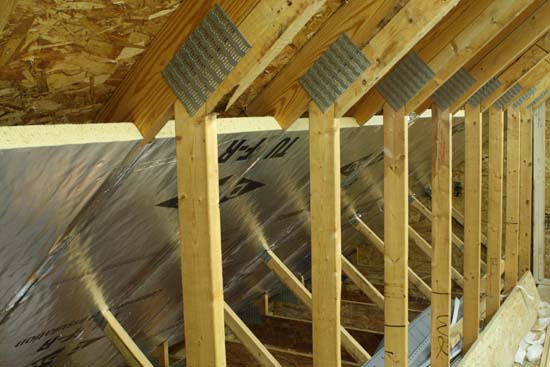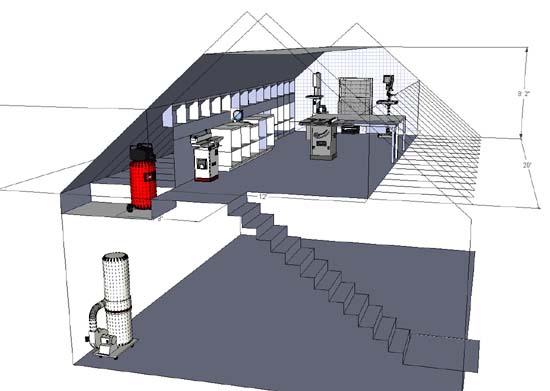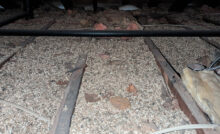Insulating Cathedral Ceiling with Foam Board
Insulating Cathedral Ceilings
Insulating Cathedral Ceilings can be quite challenging. I’m in the early stages of building an amazing workshop to showcase tools over at Tool Box Buzz and shop projects here at HCI. The new workshop will be located over my garage in an area that was framed using attic trusses when we built the new house. Attic trusses typically have a sloping ceiling (cathedral) that poses a different insulating solution.
As you can see in the photo above and the 3D model below the attic trusses create a section of sloped ceiling and flat ceiling much like you’d get in a house with a cathedral ceiling. For my situation I wanted to insulate most of the “roof” surface so that I could take advantage of storage space in the area to the sides of the walls.
Insulation Options
Obviously on a project like this there are quite a few options with varying costs and benefits. Feasible insulating options include:
- Spray Foam – Using spray foam would be an excellent option. In that situation the foam would be sprayed directly to the backside of the roof sheathing resulting in an un-vented roof. This type of un-vented roof has proven reliable when properly installed. This is by far the most expensive option.
- Blown-In-Insulation – Another un-vented option is using cellulose or fiberglass blown into the rafter cavities. For this option to work you have to install a layer of sheathing or drywall to contain the insulation. Just this past year we insulated some 4:12 pitch rafters using the BIBS System. Again this is a pretty pricey option.
- Fiberglass Batts – One of the most widely used approaches would be installing proper vent in each bay between the rafters then installing fiberglass batts. I really don’t like this approach for several reasons including the fact that it doesn’t do a good job at all of air sealing which leads to really poor fiberglass performance.
- Foam Board – The last option that I considered and the one I’m using is foil faced polyiso insulation board. I’m using 2″ foam board (2″ foil faced polyiso R value is approximately R14) fastened to the bottom of the 2×6 truss chord which leaves a nice 2-1/2″ air space. The air space will be continuous down to the soffit vents and up to the ridge cap vent. In areas where the finished sloping ceiling and flat ceiling are located I’ll also install a layer of R13 fiberglass insulation. This should bring my total insulating R value to around R27.
Insulation Details
While R27 isn’t super but it sure beats an R19 that I might otherwise get using fiberglass. Also by installing the foam board in the manner described below I’ve created a nice air seal which should make a HUGE difference.
As you can see in the adjacent photo I’m also creating a “flat” ceiling of sorts with the insulation. This is located just above the truss ceiling rafters and about 12″ below the ridge vent. This should allow plenty of good ventilation from the soffits below up to the ridge vent.
I’ll do something similar down at the base of the roof where the trusses meet the wall. At that location I’ll cut pieces about 12″ tall and seal them to the wall top plate and the sloping insulation. The important step there is not cutting off the flow of air from the soffit vents.
Once I get all the insulation in place I’ll be sure to report back on it’s performance especially in the hot sun this summer. The 2″ foil faced polyiso is costing about $1 per sq. ft and I figure the whole job will take about 30 man hours.
Recent Posts
Framing Stick Nailer vs Coil Nailer
Which is Better a Stick Nailer or Coil Nailer? Framers have many choices in nailers…
How Many Roofing Nails Per Square of Shingles
Estimating How Many Nails for a New Roof When it comes to estimating materials for…
Composite / PVC Decking – Layout Tips & Advice
Composite / PVC Decking Layout Tips and Advice Composite and PVC decking have really changed…
Benefits of an ERV System (Energy Recovery Ventilator)
Benefits of ERV Systems (Energy Recovery Ventilator) If you're building a new home or doing…
Vermiculite Attic Insulation Abatement
Vermiculite Attic Insulation If your home was built before 1990 there is a chance it…
Nuisance Tripping of AFCI (Arc Fault) Circuit Breakers
Arc Fault (AFCI) Circuit Breakers Tripping Often An arc-fault circuit interrupter (AFCI) or arc-fault detection…




View Comments
Well done sir
I've been here before... Installing the foam board is harder than it looks. Keep up the good work!
Todd, not much to say here, but I wanted to say that this is a really great article.
Thanks Fred!
Todd,
The shop is really looking great! The foil insulation is going to keep your shop cooler in the summer and warm in the winter. Nice choice and well done!
I can't wait to see the shop completed!
Hi,
I have a 1920's bungalow where the cathedral ceiling of the second story is uninsulated. I can access the rafter space from behind the knee walls and was planning on insulating with fiberglass insulation and venting. However, when I investigated closer, I found that the ceiling rafters are 2x4's, which means there is no room for vented fiberglass insulation. Would it be okay to fill this space with spray-in foam to create a "hot roof?" I don't really know what other options I have besides tearing off the roof and beefing up the rafters.
-Ryan in Milwaukee
How old is your roof? Is it near the end of it's life span? If so I'd consider insulating on top of the roof, then new sheathing and roofing. This will give you the best insulation value. Otherwise you could try to fill the voids but it's not going to work correctly because you can't get enough R value....you'll end up with ice dams.
I really like the idea, but my garage does no have a suffit but i have a ridge cap vent . any advise?
Thank you very much
Are you trying to finish the space? If so I'd recommend installing soffit vents.
Great site Todd,
My wife just bought me a two story workshop from home depot. It has a barn shape roof where the Rafters come straight off the 2nd story floor so there is no soffit I would like to insulate this shop. are these panels a good idea for my roof application, And if so there is no venting should I still leave a space between the panel and the roof sheeting? Any Ideas are welcome, and thanks in advance!
Mike
Mike - Thanks for the kind words.
I'm assuming you're talking about a gambrel roof. I'm also going to assume that you're only going to heat this workshop when you're in it rather than all the time (although it probably doesn't matter much).
I would insulate the entire ceiling/roof without any vents. In this situation it's much like a cathedral ceiling. Today most experts feel that unvented cathedral ceilings are the best.
Having said that I think you can exactly what I did in my shop but you can skip any ventilation issues and just be sure it's all sealed well. The space between roof sheathing and insulation won't matter.
Good luck. Please consider signing up for my FREE Weekly Newsletter.
Loved all the advice on insulating a ceiling. Have a few questions and would like to send a picture of my situation if you could look at it.
Thanks
Todd
Send away
todd at frontstepsmedia dot com
Hi Todd,
Excellent info here and more detailed than any other site, which I really appreciate. I have a workshop that is set up almost exactly like yours and I'm trying to insulate it properly. It was built with no soffit vents and all I have is two gable vents (12"x12") on either end. I want to insulate the roof to prevent the summer heat from heating the upper floor beyond inhabitable temperatures, however I'm worried about possible moisture entrapment, even though I live in a very dry area (Broomfield, CO). I have 2x10 rafters so there is plenty of space. I thought about just using the 8 1/4" thick fiberglass insulation and leaving a gap between the fiberglass and the roof sheathing, but still, there is no ventilation, so I'm not sure if that is the best way to go. Then I started looking into the foil faced polyiso insulation and found your site and it looks like a good way to go, but still, I don't have any ventilation. No one will be living in this space and I won't be spending much time there (only weekends) so I'm wondering if I should be too concerned with moisture and if you have any recommendations? Adding soffit vents is impossible the way the building is constructed, so the only ventilation option would be adding roof vents. Thanks.
Paul - Thanks for the compliment. Lots of roofs today are insulated with no ventilation. However, in those cases the roof is either insulated on top of the sheathing or the entire cavity is filled with insulation. Based on your situation I'd consider the following.
- Are you sure you can't get venting in? Even the small round type that are installed by drilling a hole?
- You might want to consider insulating the bays with foil faced polyiso, installed tight to the bottom of the sheathing. The polyiso is nice because it won't absorb moisture if you get a problem.
- Spray foam is another great option, but pricey.
Good luck.
Todd,
Thanks for your consideration of my situation. Much appreciated. Unfortunately, the only possible place to put a type of soffit vent, like the small round type, is a space about 2" wide that would have to go directly through the double 2x6 top plate of the wall. I thought about using the round type like you suggest but I don't think I have enough room for the 2" since the ones I've seen have a 2" insert and then extend about 1/2" past that on the face. I also thought drilling through the double top plate would be pretty difficult in such a limited space. I was also concerned about just how many of those I might need to install for each rafter bay to have adequate ventilation. I probably could install these type of vents directly into the side of the facsia, but I thought that might look kind of weird. Maybe not. How many of those type of vents would you think is necessary for each rafter bay?
Installing the polyiso tight to the sheathing might be a better option. I thought about the spray in foam method too, but wanted to avoid that expense if I could.
Again, thanks for the help here.
That's the problem, you'd need quite a few to get any decent air flow. I guess in your situation, I'd go with the foam directly on the bottom side of the sheathing unless you can afford the spray foam.
Todd,
This looks like what I need, but I'm having trouble finding someone who installs foam board in lower Fairfield County, CT. Any hints?
Thanks.
Almost any insulation sub-contractor can do the work. Just do a search for insulation contractors in your area.
Todd,
Great website!I live in Texas and it is hot! I have a two story house that gets hot upstairs. The previous owner stuffed fiberglass batts tight against the roof above the second story kneewalls. They are blocking the air flow from the soffit vents and the whirlybird on the top of the roof. If I remove the fiberglass batts and use foil polyiso to insulate this area:
1. How much air space do I need to leave between the polyiso and the roof?
2. The cathedral ceiling space in question between the top of the kneewall and the flat 2nd floor bedroom ceiling is only about 4 feet. Will the foam board be effective if it is cut tight to the rafter width and layed on top of the drywall. (the slope of the ceiling is about 45 degrees.
Thanks for your suggestions.
Max - Thanks for the nice compliment. You certainly have a tough situation. I'd definitely recommend getting the air flow back. The next question is, how much space do you have? I'd recommend at least 2 to 4 inches of foil faced foam, but you really need to leave probably 2 inches of air space.
This will certainly help. Is it perfect? no....is it your best option without tearing down the ceiling..probably.
Good luck.
I measured the space this morning and the space between the ceiling and the roof is 5 inches high. I went to the local home improvement store and the thickest polyiso they had was 3/4 with a single foil faced side.
1. Should I try to shop around town to find thicker polyiso board or just cut multiple boards and stack them in the space?
2. Do I need a foil faced side on both sides or just the side facing the roof?
I will be cutting the foam board to size so it fits snugly in between the rafters. I will not be about to tape the seals like you did because there is no room. I am excited about getting the airflow back!
Thank you again for the great website and information. It was around 100 degrees again today and the forecast is it will stay this temp for about two more months.
I would shop around. A real building supply store should carry thicker options up to 2". Foil is only really necessary on the top, but it also really helps create a great vapor barrier. If you can't tape, I'd try to use spray foam or caulking to seal the joints as best you can. Nothing is ever perfect, but I'd try hard to seal things as best you can.
BTW>.....you're very welcome. I hope you come back often.